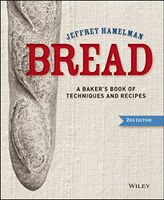Advertisement
Step Three: Bulk (Primary) Fermentation
Published 2004
As soon as the mixer is turned off, dough fermentation begins. Whatever oxygen is in the dough at the end of mixing is consumed within minutes by the yeast, and fermentation proceeds in an anaerobic state, that is, in the absence of oxygen. As a rule, fermentation is initiated either by the use of a natural leaven, elaborated from a sourdough culture that the baker maintains, and added to the dough at the time of mixing in order to generate the fermentation; the use of a yeast-generated pre-ferment such as a poolish, biga, or pâte fermentée; the addition of commercial baker’s yeast to the dough; or the combined use of two or more of these. It is during primary fermentation that the majority of the dough’s flavor develops. (Needless to say, artificially speeding up this phase by using dough conditioners, powdered sourdough, or no-time dough mixes will have consequences that emphatically detract from bread quality.)

